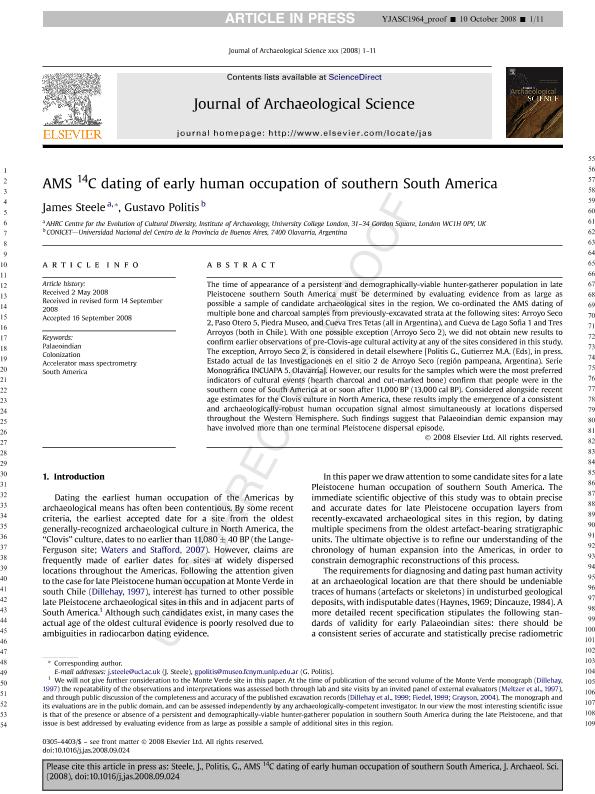Mostrar el registro sencillo del ítem
dc.contributor.author
Steele, James

dc.contributor.author
Politis, Gustavo Gabriel

dc.date.available
2022-08-03T16:24:07Z
dc.date.issued
2008-12
dc.identifier.citation
Steele, James; Politis, Gustavo Gabriel; AMS 14C dating of early human occupation of southern South America; Academic Press Ltd - Elsevier Science Ltd; Journal of Archaeological Science; 36; 2; 12-2008; 419-429
dc.identifier.issn
0305-4403
dc.identifier.uri
http://hdl.handle.net/11336/164072
dc.description.abstract
The time of appearance of a persistent and demographically-viable hunter-gatherer population in late Pleistocene southern South America must be determined by evaluating evidence from as large as possible a sample of candidate archaeological sites in the region. We co-ordinated the AMS dating of multiple bone and charcoal samples from previously-excavated strata at the following sites: Arroyo Seco 2, Paso Otero 5, Piedra Museo, and Cueva Tres Tetas (all in Argentina), and Cueva del Lago Sofia 1 and Tres Arroyos (both in Chile). With one possible exception, we did not obtain new results to confirm earlier observations of pre-Clovis-age cultural activity at any of the sites considered in this study. The possible exception, Arroyo Seco 2, is considered in detail elsewhere [Politis G., Gutierrez M.A., Scabuzzo, C. (Eds), in press. Estado actual de las Investigaciones en el sitio 2 de Arroyo Seco (región pampeana, Argentina). Serie Monográfica INCUAPA 5. Olavarría]. However, our results for the samples which were the most preferred indicators of cultural events (hearth charcoal and cut-marked bone) confirm that people were in the southern cone of South America at or soon after 11,000 BP (13,000 cal BP). Considered alongside recent age estimates for the Clovis culture in North America, these results imply the contemporaneous emergence of a consistent and archaeologically-robust human occupation signal at widely-separated locations across the Western Hemisphere. Such findings suggest that Palaeoindian demic expansion may have involved more than one terminal Pleistocene dispersal episode.
dc.format
application/pdf
dc.language.iso
eng
dc.publisher
Academic Press Ltd - Elsevier Science Ltd

dc.rights
info:eu-repo/semantics/openAccess
dc.rights.uri
https://creativecommons.org/licenses/by-nc-sa/2.5/ar/
dc.subject
ACCELERATOR MASS SPECTROMETRY
dc.subject
COLONIZATION
dc.subject
PALAEOINDIAN
dc.subject
SOUTH AMERICA
dc.subject.classification
Antropología, Etnología

dc.subject.classification
Sociología

dc.subject.classification
CIENCIAS SOCIALES

dc.title
AMS 14C dating of early human occupation of southern South America
dc.type
info:eu-repo/semantics/article
dc.type
info:ar-repo/semantics/artículo
dc.type
info:eu-repo/semantics/publishedVersion
dc.date.updated
2022-07-04T20:20:09Z
dc.journal.volume
36
dc.journal.number
2
dc.journal.pagination
419-429
dc.journal.pais
Estados Unidos

dc.description.fil
Fil: Steele, James. Colegio Universitario de Londres; Reino Unido
dc.description.fil
Fil: Politis, Gustavo Gabriel. Consejo Nacional de Investigaciones Científicas y Técnicas. Centro Científico Tecnológico Conicet - Tandil. Investigaciones Arqueológicas y Paleontológicas del Cuaternario Pampeano. Universidad Nacional del Centro de la Provincia de Buenos Aires. Investigaciones Arqueológicas y Paleontológicas del Cuaternario Pampeano; Argentina
dc.journal.title
Journal of Archaeological Science
dc.relation.alternativeid
info:eu-repo/semantics/altIdentifier/doi/http://dx.doi.org/doi:10.1016/j.jas.2008.09.024
Archivos asociados
